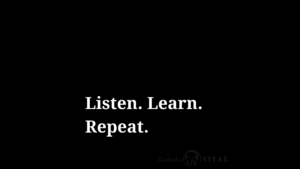I have successfully affected change for many organizations. Several years ago, I was given a group of people and told “We want you to transform this team from internally focused to a customer service organization. You have 6 months.” Another time, it was to transform from functional- to matrix-managed. Then using waterfall to agile project methodologies.
Every time an organization I work for initiates change, it’s an opportunity for me to do what I love to do. Have fun solving problems and making new, cool things that didn’t exist before.
Over the years, I have developed a method for affecting successful change. I did not learn this in school or go to some special training program to figure it out. It has been developed over twenty years of people asking me to make new things happen, trusting me to figure out how and deliver through others.
I have used different techniques in every role, with every team, simply because you have to adjust based on the nature of the change and the group you are working with. That said, there are common themes – things that I feel are absolutely critical to successfully getting any group of people to follow you into the great unknown.
 I will start with sharing my personal motto…where I begin when tackling any problem. “If you focus on people, results take care of themselves.” If I think first about what my team needs to be successful, they can help me drive to that success faster than I could ever go on my own.
I will start with sharing my personal motto…where I begin when tackling any problem. “If you focus on people, results take care of themselves.” If I think first about what my team needs to be successful, they can help me drive to that success faster than I could ever go on my own.
Theories are just that, so I’ll use an analogy as a context for the various components of successful change. Imagine bringing together a collection of athletes from different teams and experience levels. I want them to be a success together, so what do I do?
What is happening to me? (INFORM)
First, I start with recognizing that they are not yet a team. They are a collection of individuals, each with their own perspective, reasons for being here (which may not be choice), motivators, and awareness of what’s going on. Before I can get them to take one foot in a direction I want them to go, I have to give them more information…starting with – what’s going on?
Often, during change, individuals feel that it is “happening to” them, and it’s not a choice. Ultimately, we all have a choice – such as leaving and doing something else – but those choices may not be realistic. Even though professional athletes can make a lot of money, it doesn’t mean that they don’t want to have some control over their own destiny.
By talking openly and addressing head-on any fears, questions, and conjecture about what is going on and why, I can begin to help them to look past what is happening to them to the potential opportunity ahead.
What’s in it for me? (MOTIVATE)
An individual cannot focus on we/us and moving forward if you don’t address “me” first. As I said in the beginning, change brings opportunity. So, what are the opportunities in this change? Making the company more profitable? Bringing more fans into the stands? Sorry, but so what? Those are usually higher level objectives that don’t mean much to an individual in the early stages of change.
For sports teams, the lure of high-paying contracts when you are a valued player coming from a successful team might be a place to start. But maybe they already have plenty of money. Knowing someone’s motivators is critical to get them to buy into the change you are trying to affect. It might be challenging work, a flexible environment that allows them to spend more time with their family, the ability to give back in the community or opportunities for advancement. Don’t make promises you can’t keep, but tie what’s happening into a reason why they want to be here and be a part of it.
Where are we going? (INSPIRE)
Now that the individuals know what’s happening and what’s in it for them, I need to set the groundwork for them to begin to move together towards our goal. To do that, they need to understand what that goal is. I need to provide a promising vision of the future that they can rally around to keep each other motivated and start putting one foot in front of the other in a common direction.
I can’t just say “go win games.” Instead, I need to help them imagine a world where they are successful and what that success means. Hoards of people coming to watch them play, cheering as they move down the field, and coming out to line the streets when they win the championship. They need to be able to see in their mind’s eye this possible future and want to do their part to make it happen.
How can I contribute? (DEVELOP)
As we proceed, everyone will move forward at their own pace and using their own stride. To get them in lock-step, I need to train them. They need to know their role, how it fits into the overall team execution, and how to do it. It’s not enough just to tell them, you need to show them. There is nothing like OJT (on the job training), but I don’t want them trying out their newfound skills for the first time on the playing field, when it counts. I need to give them a place to practice. Providing a safe environment for them to learn allows them to make mistakes (which will happen) and learn from them.
Along the way, each individual will fumble, throw interceptions, or miss tackles. Giving them a chance to try out their new skills, learn from their mistakes, and get better – with support instead of criticism – is critical for them to feel comfortable stretching themselves when it’s game time. No one wins by just following the rule book, doing things that have already been tried and playing it safe. Stretching the limits has the potential for great risk and amazing rewards. But most individuals won’t feel comfortable stretching the limits unless they know they are encouraged and supported, even if they fall.
What do I need to be successful? (RESOURCE)
Sending a team out on the field with the proper equipment should be a given. Depending on the sport, they may need a glove or a bat, a ball or a stick. Without the proper resources, even the most knowledgeable and skilled players cannot be successful. Enough said.
How do we get there? (EXECUTE)
Now that folks know where they’re headed, have knowledge and some experience in their roles, as well as the tools of their trade, they need to know how to get there. You have to have a plan. It might be a project plan, a battle plan, or a game plan, but you have a plan to move your resources forward towards the vision you set at the beginning.
The first time the team gets out on the field, and find themselves deep in enemy territory, they may not be sure what to do. The game plan can’t just be “win the game” or “score.” Focus on an early win. Don’t worry about getting to the end zone. Focus on the first 5 yards or just the very next play. What are the immediate next steps they need to take to move forward together? By giving them an early win, you can continue to ask more of them. If they are paralyzed by the long road ahead to victory, you can’t even get started. Instead, give them manageable and achievable goals that do not seem like that much of a stretch given where they are, what they know, and where they are in their evolution as a team.
In the beginning, you will need to set the plays within the game plan so they know they can be successful together as a team. Quickly transition to bottom up empowerment. What do they think is needed? What plays do they want to make? Why? Because they are out on the field, they know the game and the opponent, and have more hands-on experience than the coach. How long has it been since the coach or owner played ball? Give them the parameters for success – the boundaries if you will – and then encourage them to work together to help define the details. Before you know it, you can just say “win the game” and they will.
Is this the right way? (COMMUNICATION)
I will never say it enough. Communicate Communicate Communicate. If you do everything else right, and fail to do this well, your team will fail. It is key to the success of all teams. Continually reinforce where we’re headed, why we are headed there, and what we all need to do to be successful. Maybe more importantly, communicate that you know we can be successful. That you know, together, we can achieve that glorious vision.
You’ve done all you can to set them up for success. You have a game plan, with an empowered team that can call the plays on the field. They have the knowledge, experience and resources they need to be successful. Now it’s time to execute. As they are driving down the field, wondering if they are doing okay and headed the right way, run onto the field at time outs with water and reassurance that they are doing awesome. If there are adjustments you can see are needed, share them. If it’s just jumping and cheering on the sidelines, continuing to be told by the line judge to get back off the field, demonstrate your passionate conviction in their ability. As the team evolves and can move down that field on their own, with little direction or input from you, they will still need to look up periodically and check their compass to know they are headed in the right direction. As their leader, you are their true north.
Bringing it All Together (Kristin’s Secret Sauce)
If you look at the steps I’ve outlined, it might seem a little backwards. Clearly, I’m communicating throughout. I also have a game plan in my back pocket from the beginning. My real secret is focusing on the individual first.
I create a common vision that can bring them together as a team, but only after their individual needs are addressed. As a team, I look to provide them each with the knowledge and tools they need to begin their journey and a safe place to begin execution on some of my game plan. They may not know the full end game yet, but if they understand and buy-in to the vision, and I have laid the groundwork of trust by addressing their individual needs, they’ll begin to move forward.
As they see more of the game plan, and are more comfortable in their roles and ability to execute, I turn more and more over to the team to determine the on-the-ground plays. I just make sure what they are doing aligns to the overall game plan and vision. And in everything, I communicate. I recognize when they are doing well and help them make adjustments when needed.
Along the way, I migrate from a more active participant and coach in practice, to their symbol – their true north – at game time.
Now you have my secret sauce. Of course, I doubt it’s much of a secret and much of this you could probably learn somewhere. That said, if it were common, well understood, and easy to execute, then maybe change wouldn’t be such a scary thing for so many. I just try to make it as easy for my team as possible, focusing on them first…and letting the results take care of themselves.










5 Responses
Hi there, You have done a great job. I’ll definitely digg it and personally recommend to my friends. I’m sure they will be benefited from this site.
Thank you! I was not familiar with digg and started doing research after your feedback. I have already found some great articles and can see the value. I appreciate the support – and the new communications vehicle!
Kristin
It’s perfect time to make a few plans for the long run and it is time to be happy. I have read this post and if I may just I desire to counsel you some interesting issues or advice. Maybe you could write next articles referring to this article. I desire to learn more things about it!
I do plan on a follow up at a later point. I’m still “cooking” if you will. Thank you for taking the time to read through the article and post a comment. I appreciate it.
Kristin